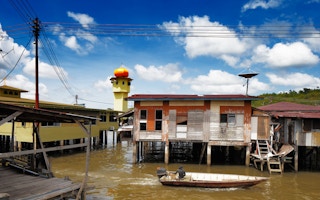The global chemical industry could save S$1.4 billion a year in electricity costs with a new technology being developed by Singapore researchers that can recycle waste hydrogen.
To continue reading, subscribe to Eco‑Business.
There's something for everyone. We offer a range of subscription plans.
- Access our stories and receive our Insights Weekly newsletter with the free EB Member plan.
- Unlock unlimited access to our content and archive with EB Circle.
- Publish your content with EB Premium.
This initiative by researchers from the Nanyang Technological University (NTU) is one of seven research projects focusing on energy solutions in renewables and microgrids, which received $15 million in funding from the Singapore government on Tuesday.
The researchers from NTU’s Energy Research Institute won funding for a project to develop a catalyst for fuel cells to generate electricity from the hydrogen contaminated with chlorine that is produced as a by-product of chlorine manufacturing.
About 68 million tonnes of chlorine is produced worldwide annually, and an estimated 10 to 15 per cent of the hydrogen produced is emitted into the atmosphere.
Professor Chan Siew Hwa, the principal investigator for this project, explained to Eco-Business that this emitted hydrogen contained small amounts of chlorine, which is why it was unusable in conventional fuel cells which use platinum as a catalyst.
These catalysts can only process pure hydrogen, and the presence of impurities such as chlorine - even as little as one part per million - would poison the catalyst and destroy the fuel cells, said Chan. He added that the fuel cells in question are low-temperature proton exchange membrane fuel cells, which are commonly used in automobiles.
If a catalyst existed that could generate electricity from chlorine-contaminated hydrogen, the hydrogen that is currently wasted by chemical plants could be redirected to power fuel cells, said Chan.
Fuel cells containing this catalyst could be used to build a small power plant on the premises of chemical factories, and the energy generated there could offset the electricity bills of these facilities. This move could achieve S$1.4 billion in electricity savings per year globally, according to the research team.
Chan noted that “successful implementation of this project will not only help to improve the energy efficiency and productivity of chemical plants in Singapore and other parts of the world, it will also reduce the carbon footprint of the chemicals industry”.
The seven winning projects from NTU and the National University of Singapore (NUS) came from a grant call by the country’s Energy Innovation Research programme (EIRP), a $140 million fund for the energy sector managed by the Energy Innovation Programme Office (EIPO).
The EIPO is a multi-agency initiative to develop the country’s energy sector and is led by the Singapore Economic Development Board (EDB) and the Energy Market Authority. It receives funding support from the National Research Foundation.
The research grant called for ideas to diversify clean energy generation options beyond solar energy, which has so far been the focus of much of Singapore’s efforts in developing renewable sources.
The innovations emerging from this research could be applied in Singapore and South East Asia, said EDB, who added that that further research and development are “crucial” to adapt clean energy systems to the region’s unique topography and climate.
“
These projects will strengthen Singapore’s position as the leading hub for innovation and commercialisation of clean energy solutions in Asia.
Yeoh Keat Chuan, managing director, Singapore Economic Development Board
The second focus area of the EIRP’s grant call – microgrids – was a response to the rising demand for this technology in the region, said EDB.
Microgrids are small-scale electricity grids that are powered by diesel or renewable sources, and can be operated independently or connected to a city’s main grid to serve as a source of back-up power.
As a means of back-up power, microgrids are seen as a cleaner and cheaper alternative to diesel-powered generators. As an independent electricity system, they are also a faster and cheaper way to bring electricity to isolated areas in the region, rather than extending the grid to reach these locations.
The microgrid market in the region is expected to see a tenfold increase in revenue size from US$84.2 million in 2013 to about US$814.3 million by 2020, according to analysis by consulting firm Frost & Sullivan.
Indonesia, where the International Energy Agency estimated that 81.6 million people lived without access to electricity in 2009, aims to install microgrids that will bring electricity to 90 per cent of its off-grid population by 2025.
One microgrid project that received funding was an initiative by NUS researchers that would devise a hybrid diesel-solar photovoltaic (PV) power generating system, and would determine the most economically optimum mix of solar and diesel power to be used in it.
Associate professor Sanjib Kumar Panda, principal investigator of the project, which will be carried out in partnership with German renewable energy firm Younicos and Singaporean investment holding company Gallant Ventures, said that the team aims to commercialise this technology to microgrid projects in the region.
Yeoh Keat Chuan, managing director of EDB and co-executive director of EIPO, noted the growing demand for clean energy and microgrids in the region, and expressed confidence that these funded research projects would help Singapore bring clean energy and microgrid technology to regional markets.
“These projects will strengthen Singapore’s position as the leading hub for innovation and commercialisation of clean energy solutions in Asia,” he added.










